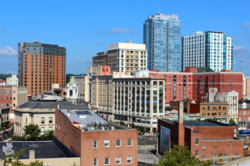This article needs additional citations for verification. (October 2010) |
Downtown Stamford Historic District | |
 Downtown Stamford, looking west | |
| Location | Atlantic, Main, Bank, and Bedford Sts. (original); Roughly, Bedford St. between Broad and Forest Sts. (increase); Stamford, Connecticut |
|---|---|
| Coordinates | 41°3′8″N 73°32′25″W / 41.05222°N 73.54028°W |
| Area | 17.2 acres (7.0 ha) 3.7 acres (1.5 ha) (1984 increase) 5 acres (2.0 ha) (2003 increase) |
| Architect | Multiple |
| Architectural style | Late 19th and 20th Century Revivals, Late Victorian, Commercial Vernacular, Late 19th And 20th Century Revivals, Modern Movement |
| Website | stamford-downtown.com |
| NRHP reference No. | 83003502 (original) 85000311 (increase 1) 02001744[1] (increase 2) |
| Significant dates | |
| Added to NRHP | October 6, 1983 |
| Boundary increases | February 21, 1985 January 31, 2003 |
Downtown Stamford, or Stamford Downtown, is the central business district of the city of Stamford, Connecticut, United States. It includes major retail establishments, a shopping mall, a university campus, the headquarters of major corporations and Fortune 500 companies, as well as other retail businesses, hotels, restaurants, offices, entertainment venues and high-rise apartment buildings.
Since 2000, new development has consumed much of the Downtown area, with the additions of new high-rise buildings and office towers such as the 34-story Park Tower Stamford formerly Trump Parc Stamford, parks such as the new Mill River Park, and housing such as the new 17-story Highgrove Condominium Residences. Other development projects include new student housing at the UCONN Stamford branch, residential housing, and the planned Ritz-Carlton Stamford development, which will include two 39-story hotel/condominium towers. The city also plans to make improvements to the Atlantic Street underpass beneath the New Haven Line railroad tracks just east of the Stamford Transportation Center in order to alleviate a traffic bottleneck.[2] The improvements are also meant to allow quicker evacuation of areas of the South End if disaster strikes.[citation needed] The project received a $245,000 earmark in the federal budget passed in December 2007.[2]
- ^ "National Register Information System". National Register of Historic Places. National Park Service. March 13, 2009.
- ^ a b Porstner, Donna, "Stamford to get $7M from feds", The Advocate (Stamford), December 20, 2007, Stamford edition, page 1